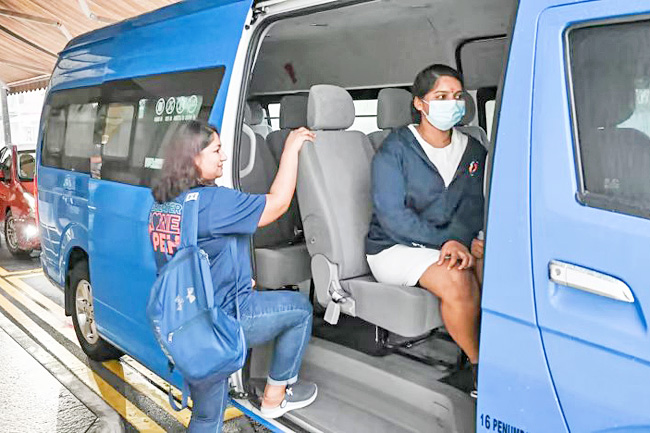CNA – Staff nurse Prasana Devi Mathavan used to rent in Singapore. But after the rent went up by 50 per cent after the pandemic and she could not afford to live there.
The Malaysian decided to move to Johor Bahru. She travelled daily across the Causeway to her job at Parkway East Hospital. The long commute took a toll, and in February, Prasana quit.
Two months later, the 33-year-old returned to the hospital when she heard it was starting a shuttle bus service to fetch nurses living in Johor Bahru to and from work.
“I find there’s work-life balance with this shuttle bus service … before, I had very limited time at home,” she said.
This is one of the initiatives hospitals in Singapore have taken to retain nurses, amid concern about manpower shortage in the healthcare industry.
The attrition rate of nurses in Singapore, and especially foreign nurses, increased in 2021, according to figures provided by the Ministry of Health in a parliamentary reply last August.
Among locals, the attrition rate that year was 7.4 per cent. For foreign nurses, it was even higher at 14.8 per cent. The long working hours, shift work and better job opportunities are some factors that drive them to leave.

Like Prasana, senior staff nurse Lingeaswary Chendra Mohhan used to face a much longer commute from her Johor Bahru home to Gleneagles Hospital in Singapore, where she works.
The 34-year-old used to wake up at 3am for her 7am shift, and her commute involved four public buses.
With the shuttle bus, she now wakes up at 3.45am and gets to the hospital at 6am. She takes the extra hour to rest and have breakfast before starting work.
Mohhan, who is taking her master’s degree in public health, also gets home an hour earlier than before, giving her more time to study.
Other nurses told CNA they now have more time with their family. Nishanti Vikaraman, a 35-year-old mother, was thinking of resigning after giving birth to her third child. The long hours of travelling also meant she had little energy and time to spend with her children.
There were times she got home at midnight despite ending her shift in the afternoon. Then she had to wake up by 3am for a morning shift the next day, she said.
“Sometimes I had no rest at all. I’m lying down but not really sleeping… because we’re thinking we have to get ready to work,” she said.
“I felt really exhausted … (and that I had) no choice, have to resign. But since taking the shuttle service, I can reach home earlier.”
IHH Healthcare Singapore said more than 300 employees across its four hospitals are taking the shuttle service. Demand is outstripping current capacity, so it plans to add more buses.
The company is Singapore’s largest private hospital operator and runs both Gleneagles and Parkway East hospitals.
The COVID-19 pandemic has created pent-up demand for nurses who wanted to emigrate but could not do so due to travel restrictions, IHH said.
Attrition rates across all healthcare operators rose in 2022 when borders reopened, it added, although the situation improved in the first half of this year.
IHH and other healthcare institutions CNA spoke to said they have instituted some measures to improve nurses’ working conditions.
For instance, IHH nurses now have a five-day work week, whereas before they had three days off every two weeks. Nurses also said they get more help with routine work – healthcare assistants help with chores like bathing patients and answering call bells – so they can focus on more complex tasks.
Public hospitals also said they have implemented a more flexible work schedule and other innovations to help nurses cope better.
Assistant director of nursing at Tan Tock Seng Hospital (TTSH) Sui Huangbo said the hospital is engaging nurses on how their workload and job scopes can be adjusted to better meet their needs. It is also working towards giving nurses greater autonomy over their shifts.
“We have also improved the work-shift patterns for nurses to increase rest periods between shifts,” said Sui.
The hospital has also launched trials using digitalisation, robotics and artificial intelligence to streamline the nurses’ work so they will not be burdened by repetitive and labour-intensive tasks, she said. Fourteen initiatives that were tested in TTSH’s SMART facility have already been introduced.
Examples include automated bed turners to help turn bedbound patients, assisted shower devices, meal delivery robots and smart beds that prevent falls.
Yishun Health is also relying on robots to take on routine tasks. Chief nurse Shirley Heng said that since November last year, robots at Yishun Community Hospital wards have been delivering small items to patients and making announcements.
“It has reduced rote work, allowing our nurses to dedicate their time to delivering clinical care and having more direct and meaningful engagement with patients,” said Heng.
The feedback has been positive, so there are plans to explore deploying the autonomous robots at Khoo Teck Puat Hospital.
Heng said healthcare assistants are also being trained and taking on higher-level caregiving support roles. This has freed up time for nurses to concentrate on clinical nursing care, she added. – Chew Hui Min


